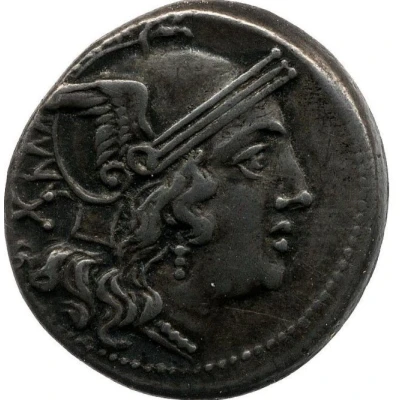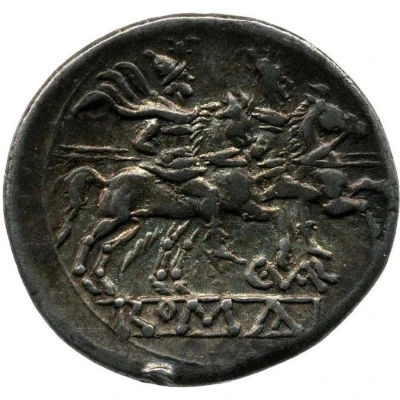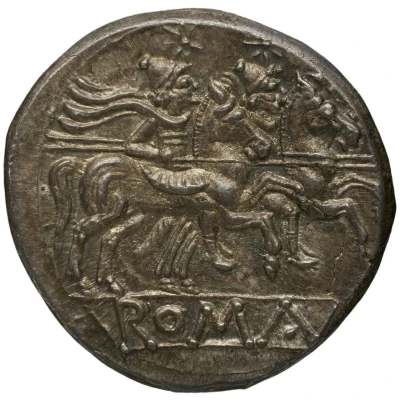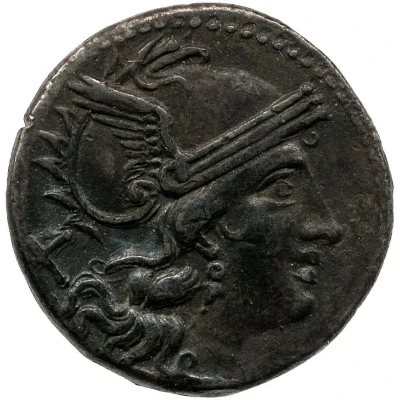
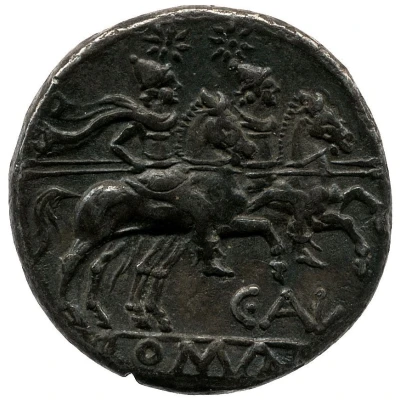

© British Museum
Denarius Aelia: Caius Aelius, X/C. AL ROMA 209 BC - 208 BC
| Silver | 3.91 g | 19 mm |
| Issuer | Rome › Roman Republic (509 BC - 27 BC) |
|---|---|
| Period | Republic (509 BC - 27 BC) |
| Type | Standard circulation coin |
| Years | 209 BC - 208 BC |
| Value | Denarius (1) |
| Currency | Denarius of 10 Asses (221 – 141 BC) |
| Composition | Silver |
| Weight | 3.91 g |
| Diameter | 19 mm |
| Shape | Round (irregular) |
| Technique | Hammered |
| Orientation | Variable alignment ↺ |
| Demonetized | Yes |
| Updated | 2024-10-06 |
| Numista | N#231933 |
|---|---|
| Rarity index | 100% |
Reverse
The Dioscuri on horseback, galloping to the right, naked with the cloak floating over the shoulder, wearing a cap surmounted by a star, each holding a javelin; linear legend ROMA highlighted in a cartouche, surmounted by the initials of the praenomen and the monetary name.
Script: Latin
Lettering:
C.AL
ROMA
Comment
Currency minted in Sicily.For this type, Crawford found an estimate of 40 right and 50 reverse wedges. It is one of the first currencies with a monetary name.
CGB
This monetary is, without doubt, a descendant of C. Allius Paetus consul in 468 (286 BC); we have no historical details about his career; he had to exercise the office of monetary magistrate around the year 537.
The interpretation of the monogram AI by Allius rather than by Allienus or any other name beginning with AL, does not seem absolutely certain to us. Be that as it may, the denarius that we are describing here has a great striking analogy with the denarius of C. Terentius Varro, and the denarii without a magistrate's name which bear on the reverse either an ear or the hammer called ascia. The three figures who minted these coins were probably from the same college.
[u] Ernest Babelon [/ u], [i] Historical and chronological description of the coins of the Roman republic [/ i], p.108-109
At number 287 * of H.A Grueber's work, we find a mention of a variety for denarius. It is identifiable on the coin by the presence of a lock of hair on the left shoulder (1).
We also find this variety in the work of Michael Crawford (2). The 75 / 1c variant described in the book concerns a coin with the head of Rome differently engraved, identifiable by the border of the helmet behind the head and by the wick covering the ear, absent.
Without wick (coin illustrating the sheet):
With wick:
With bit and head engraved differently:
75 / 1c:
75 / 1b:
-------------------------
(1): lock of hair on l. shoulder (BMC / RR, vol.1, p.34, n ° 287 *)
(2): but loop beneath visor and curl on l. shoulder (RRC, n ° 75 / 1b)
Interesting fact
The Denarius coin was minted during the Roman Republic, a time when Rome was still a republic and not yet an empire. The coin features the image of Caius Aelius, who was a Roman consul in 209 BC. The "X/C. AL ROMA" inscription on the coin stands for "Caius Aelius, Consul, Rome," indicating that it was minted during his consulship. It's interesting to note that the Denarius was a widely used coin throughout the Roman Republic and Empire, and it remained a standard coin for centuries. Its design and value changed over time, but it remained an important part of the Roman economy. Today, coins like the one are highly sought after by collectors and can sell for thousands of dollars at auction.
